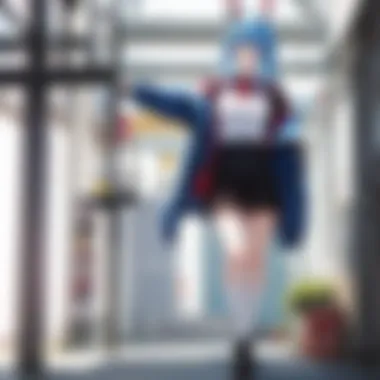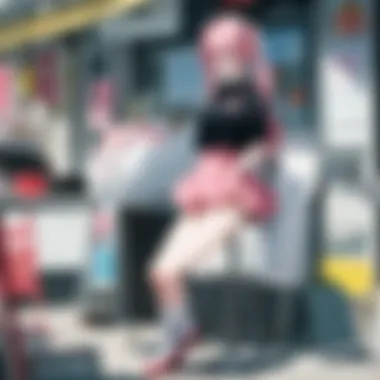Exploring the Cultural Significance of Bunny Senpai


Intro
The Bunny Senpai movie has carved a unique niche within the expansive universe of anime. It stands not just as entertainment but as a significant cultural artifact. This film, while initially appealing to a younger demographic, resonates with a broader audience through its nuanced storytelling and character portrayals. The themes it explores invite viewers to reflect on their own experiences, offering a relatable and profound narrative.
Character Profiles
Overview of Main Characters
At the heart of this film are its richly developed characters. The protagonist, Sakuta Azusagawa, is a high school student who grapples with existential challenges and emotional turmoil. His interaction with Mai Sakurajima, a former child actress, encapsulates the complexities of adolescence, fame, and personal identity. Mai's struggle with her fading popularity and her quest for recognition form the core of the film’s emotional landscape.
Sakuta’s interactions with other characters, particularly those suffering from their own unique phenomena, showcase his growth and empathy. This development is central to understanding the film's narrative depth.
Supporting Characters
Supporting characters add further richness to the storyline. For instance, characters like Futaba Sakura and Tomoe Kawai represent various facets of youth and the challenges they face. Each character’s journey complements Sakuta and Mai’s story, weaving a multicolored tapestry that reflects the struggles and joys of young adulthood.
Theme Exploration
Central Themes
The film delves into several pivotal themes. The primary theme revolves around the concept of adolescence and the invisible burdens carried during this developmental stage. Mental health, identity, and the quest for self-acceptance are intricately portrayed. Throughout the movie, viewers witness how each character deals with their respective challenges, making it a profound commentary on personal growth and resilience.
Moreover, the element of supernatural phenomena serves as a metaphor for societal pressures and personal dilemmas. Each character's unique situation often mirrors their internal conflicts, blending fantasy with realism.
Cultural References
Bunny Senpai is grounded in Japanese culture, reflecting societal expectations and the pressures placed on youth. It integrates elements of popular culture and media, such as references to social dynamics in schools and the impact of celebrity culture. These aspects create a familiar backdrop for audiences, fostering deeper connections with the narrative.
Popular Series and Recommendations
Top Anime Series of the Year
Aside from Bunny Senpai, several notable anime series have gained attention this year:
- Attack on Titan - A captivating tale of survival against colossal threats.
- Demon Slayer - Features stunning visuals and deep characters.
- Mob Psycho 100 - Blends humor and action while tackling emotional themes.
Each series, like Bunny Senpai, explores intricate themes and character developments, appealing to various segments of the anime community.
Hidden Gems in Manga
For readers looking to expand their horizons beyond mainstream titles, consider:
- Kaguya-sama: Love Is War - A witty take on romance and intelligence.
- Fruits Basket - A heartwarming and emotional journey addressing family and acceptance.
- Land of the Lustrous - A visually distinct story with profound philosophical undertones.
These works may not always receive mainstream acclaim but offer rich narratives that complement the exploration of themes evident in Bunny Senpai.
"Anime often reflects the complexities of modern life, providing insight into personal struggles through the lens of fantasy."
Through an analytical approach to Bunny Senpai, we gain not only a deeper appreciation of this specific film but also of the broader anime landscape. Its ability to spark discussions on societal and psychological issues marks it as an essential viewing for enthusiasts.
Prologue to Bunny Senpai


The film Bunny Senpai has emerged as a noteworthy piece in contemporary anime, captivating audiences with its unique narrative and complex characters. This section serves as a vital exploration of the film's foundational elements, providing insights into its significance in the broader context of anime cinema. By examining the aspects that distinguish Bunny Senpai, we can appreciate how it resonates with viewers and its contributions to the genre.
What Defines the Bunny Senpai Genre
Bunny Senpai encapsulates a genre that blends elements of romance, fantasy, and psychological drama. This blend creates a narrative steeped in both whimsy and emotional depth. The genre often involves teenage protagonists navigating the complexities of youth, highlighting both the joyful and painful moments of their coming-of-age experiences.
In this context, the character development stands as a crucial element. Each character is intricately crafted, often resonating with real-life struggles such as identity, relationships, and mental health issues. These themes allow the audience to connect deeply with the story, transcending mere entertainment.
The genre also typically includes fantastical elements that serve as metaphors for emotional or social challenges. In Bunny Senpai, these themes manifest through the narrative's supernatural components, which reflect the internal battles faced by the characters. The combination of realism and fantasy is characteristic of the Bunny Senpai genre, reinforcing the relevance of its themes in modern society.
Overview of the Film's Plot
Bunny Senpai unfolds the story of a high school student grappling with his social environment and emotional state. The central plot follows the protagonist as he navigates life while experiencing surreal phenomena, which serve as a metaphor for his struggles with acceptance and identity.
The narrative begins with seemingly isolated events that spiral into deeper connections among characters. As the story progresses, these supernatural occurrences become pivotal in revealing the characters' vulnerabilities, desires, and insecurities.
Key turning points in the plot introduce various challenges that each character must confront, ranging from issues of social anxiety to romantic misunderstandings. As the protagonist seeks to unravel the mystery behind these events, the journey unfolds into a poignant exploration of youth, love, and the pursuit of understanding one's self. Through this journey, Bunny Senpai invites viewers to reflect on their own experiences with growth and self-discovery.
Overall, Bunny Senpai presents a narrative that is simultaneously engaging and thought-provoking, reflecting both individual and collective experiences. While it entertains, it also encourages audiences to engage with deeper concerns, solidifying its place in the anime landscape.
Character Analysis
In any narrative, character development is a critical element that shapes the viewer's experience and appreciation of the story. In the context of Bunny Senpai, the characters are more than mere plot devices; they serve to explore themes of identity, connection, and emotional growth. Understanding these characters provides insight into the film’s broader commentary on societal and psychological issues. Here, we will examine how character analysis contributes to the richness of the movie.
Main Characters and Their Development
The main characters in Bunny Senpai are not only central to the narrative but also represent a variety of emotional and social struggles. The protagonist, Sakuta Azusagawa, is a high school student dealing with challenges that are both personal and societal. His journey is marked by his deep understanding of the complexities of youth. Sakuta undergoes substantial development throughout the film. He transitions from that of an outsider struggling with social anxiety to a more self-assured individual who seeks to understand and support those around him. This development is crucial not just for his narrative arc, but also for the emotional resonance of the film.
Another key character is Mai Sakurajima, a former child actress facing her own demons. Her character grapples with issues related to visibility and significance in a rapidly changing world. Mai’s evolution from a withdrawn figure to someone who learns to embrace her identity parallels many young people’s experiences in contemporary society. This aspect of her character's journey also emphasizes the importance of self-acceptance and the need for genuine connections.
Supporting Characters and Their Roles
Supporting characters in Bunny Senpai enhance the storyline by providing contrast and depth to the main characters. For instance, the character of Tomoe Koga serves as a foil to Sakuta, highlighting his growth and the complexities of his relationships. Tomoe embodies certain themes of longing and isolation, showcasing how personal experiences can shape one's interactions and expectations of love.
Additionally, characters like Rio Futaba add layers to the narrative. Rio’s own struggles with identity and recognition serve to reinforce the challenges faced by young individuals. Each supporting character is intricately linked to the main protagonists, and their unique challenges create a multi-dimensional view of the issues explored.
Character Relationships
Character relationships form the backbone of Bunny Senpai. The interactions between Sakuta and Mai create a profound emotional narrative. Their relationship encapsulates themes of love, trust, and vulnerability. These emotions vary from tender moments of support to stark confrontations about their fears and insecurities. Such dynamics allow the film to dive deeply into the significance of intimacy in fostering resilience in young people.
Moreover, the relationships among the supporting cast further enrich the story. They serve to connect various strands of narrative, illustrating how interconnected personal struggles can be. The organic development of these relationships paints a realistic portrayal of youth and their complex emotional landscapes. As characters confront each other and reflect upon their experiences, the film invites the audience to ponder their own connections and the importance of empathy in understanding one another.
Character development in Bunny Senpai exemplifies the intricate interplay between individual identity and relational dynamics, highlighting the importance of understanding in both personal and social contexts.
In summary, character analysis is essential to grasping the thematic significance of Bunny Senpai. Through the exploration of main and supporting characters, including their development and relationships, the film offers insights into the trials of youth and the profound connections that shape our experiences.
Cultural Context
Understanding the cultural context of Bunny Senpai is crucial. This film does not just entertain; it also provides insights into Japanese society, its traditions, and challenges. The cultural background adds layers to the narrative, enriching viewer interpretation. It also helps in recognizing how societal norms influence character behavior and plot development.
Japanese Society and Its Representation
Bunny Senpai effectively illustrates various aspects of contemporary Japanese society. The film captures the complexities surrounding youth, particularly in how they navigate expectations from family and society. Characters experience pressures related to academic success and social acceptance. This reflects a broader phenomenon in Japan where young people often feel overwhelmed.
In several scenes, we see students engaging in conversations that reveal their insecurities. For instance, the protagonist struggles with anxiety regarding his future. His experiences mirror those of many in Japan, where high academic standards can lead to significant stress. The film adeptly portrays this tension, making it relatable for a global audience. Additionally, the use of similar anxieties in character storytelling deepens the viewer's connection to the characters.
Cultural Norms and Values Explored


Cultural norms play an important role in shaping the themes of Bunny Senpai. The film critiques traditional views on mental health. It aims to destigmatize discussions around emotional struggles among young people. The importance of seeking help is a key message communicated through character interactions.
Within the narrative, values such as loyalty, friendship, and perseverance are strongly evidenced. Characters support one another in moments of vulnerability. This emphasizes the collectivist nature of Japanese culture, where community often takes precedence over individualism.
Moreover, the film includes cultural symbols and practices, such as seasonal festivals and student rituals, enriching the viewer’s understanding of Japanese life. These elements invite viewers to immerse themselves in the cultural richness, providing a thoughtful examination of what it means to grow up in Japan today.
Themes in Bunny Senpai
The themes presented in Bunny Senpai offer rich layers of meaning that resonate deeply with audiences. It not only entertains but also provokes thought around significant social issues. This section delves into three primary themes: youth and identity, mental health and social anxiety, and romantic relationships alongside emotional growth. Understanding these themes enhances appreciation of the film's narrative nuances.
Exploration of Youth and Identity
Youth serves as a prominent backdrop in Bunny Senpai. The film addresses the struggle of young individuals finding their identity in a rapidly changing world. Each character embodies various aspects of this journey, navigating the challenges of self-discovery. The protagonist, for instance, grapples with societal expectations while attempting to carve out a personal path. This exploration reveals how adolescence is not just a phase but a formative period that shapes one's future.
The impact of peer pressure and parental influences is evident throughout the film. Characters deal with external expectations that often contradict their desires. The narrative effectively illustrates how one’s quest for identity intertwines with friendships and interpersonal relationships. Moreover, by showcasing diverse experiences of youth, Bunny Senpai invites viewers to reflect on their own formative years.
Mental Health and Social Anxiety
Mental health is another critical theme in Bunny Senpai. The film does not shy away from showcasing the struggles that come with social anxiety. One striking aspect is the representation of characters facing emotional hurdles that limit their social interactions. This portrayal is crucial as it sheds light on mental health stigma still present in society today.
Bunny Senpai addresses how misunderstandings and lack of communication can exacerbate mental health issues. For example, the characters' internal conflicts often lead to isolation. This isolation, in turn, creates a cycle where anxiety thrives. The narrative encompasses the importance of seeking help and understanding one’s emotional state, reminding viewers that it’s okay to be vulnerable.
"Bunny Senpai uniquely encapsulates the silent battles many face, creating a narrative that is both relatable and enlightening."
Romantic Relationships and Emotional Growth
Romantic relationships in Bunny Senpai are depicted with a level of complexity that enhances character development. The film explores how relationships contribute to emotional growth, shaping the paths the characters navigate. Through various interactions, we see how love can act as both a catalyst for healing and a source of overwhelming pressure.
The central relationship showcases the nurturing nature of mutual support. Characters learn to communicate openly, express their insecurities, and acknowledge their strengths. This evolution signifies that love is not merely a romantic pursuit but also a journey of self-discovery and mutual understanding.
Additionally, the film elevates the concept of emotional growth as integral to romantic dynamics. Each character learns valuable lessons about trust, vulnerability, and the balance between independence and interdependence. In this way, Bunny Senpai underscores that personal growth often runs parallel to one’s relationships, making it a pivotal aspect of the narrative.
Visual and Aesthetic Elements
The visual and aesthetic elements of Bunny Senpai play a crucial role in conveying its themes and enhancing the storytelling. The animation quality, design choices, and overall aesthetic contribute significantly to the viewer's experience. They set the tone of the film and create emotional resonance, making it more than just an entertaining visual spectacle.
Animation Style and Techniques
Bunny Senpai employs a distinctive animation style that captures the nuances of character emotions and the subtleties of their interactions. The animation is fluid and detailed, allowing for expressive character moments that resonate with the audience. The use of character design is also noteworthy. Each character is crafted with unique traits that reflect their personalities. For instance, the protagonist’s design includes softer lines and a warm color palette, suggesting vulnerability and approachability.
Moreover, techniques like dynamic camera angles and creative framing enhance the storytelling by adding depth to scenes. The cinematography mirrors the characters' emotional journeys—shifts in focus or background can highlight a character's isolation or their connections with others. These choices are intentional and enhance the film’s emotional impact.
Color Palette and Its Significance
The color palette in Bunny Senpai is not merely decorative; it serves as a narrative device. Soft pastels dominate the backgrounds, creating an inviting atmosphere that stands in contrast to the complex issues explored within the story. This juxtaposition invites viewers to engage with deeper themes beneath a visually appealing surface.
Each scene is carefully colored to reflect the emotional tone. Warm hues surround moments of joy or connection, while cooler colors tend to accompany scenes of conflict or sorrow. This strategic use of color helps communicate the characters' psychological states, making it an essential aspect of the film's storytelling.
"The right color can evoke specific emotions and guide the audience's psychological experience throughout the film."
Understanding these visual and aesthetic elements gives viewers insight into the film’s broader themes. Together, these components create an immersive experience that contributes to the film’s unique identity within the anime landscape. As viewers delve into the intricate world of Bunny Senpai, they find that the aesthetics are not just beautiful—they are a vital part of the storytelling framework.
Impact on the Anime Community


The Bunny Senpai movie has made a notable impact on the anime community, resonating with audiences both domestically and internationally. This film is not just a story; it reflects broader themes and concepts that resonate deeply within the cultural fabric of anime. Understanding its impact involves analyzing the reception it received and the influence it has exerted on subsequent works in the genre.
Reception Among Fans and Critics
The reception of Bunny Senpai among fans and critics has been overwhelmingly positive. Many viewers praise its innovative storytelling and relatable characters. Critics have highlighted its ability to tackle complex themes like mental health and social dynamics, which are often overlooked in mainstream media. The blend of fantasy and realism is a reason many appreciate the film. Moreover, Bunny Senpai has received multiple awards, further cementing its place in the hearts of its audience.
Fan reactions have been documented on platforms like Reddit and various anime forums. Discussions frequently revolve around character development and thematic depth, showing that audiences are engaged not just with the plot but also with its messaging. This engagement signifies that the film has successfully struck a chord with its viewers. Here are some responses observed:
- Emotional Connection: Many fans relate personally to the struggles faced by the characters.
- Thematic Exploration: Viewers appreciate the boldness with which the film addresses social anxiety and youth identity.
- Visual Appeal: Critics often mention the stunning animation, which enhances the viewing experience.
Influence on Subsequent Works
The influence of Bunny Senpai extends beyond its immediate success. It has set a new standard for storytelling in anime. Following its release, other creators have aimed to replicate its blend of depth and entertainment. Notable trends can be observed:
- Character-Driven Narratives: Subsequent films have increasingly focused on character development as a priority, emulating the nuanced portrayal seen in Bunny Senpai.
- Incorporation of Social Issues: More creators are now willing to address mental health and societal challenges, paving the way for a new generation of anime that seeks to engage on deeper levels.
- Aesthetic Influence: The animation techniques used in this film are being referenced in many new anime, showcasing a distinct style that has gained recognition.
Comparative Analysis
The Comparative Analysis section plays a crucial role in understanding the Bunny Senpai movie's unique contributions to the anime landscape. By evaluating this film against other notable anime works, one can identify both its distinct attributes and shared motifs. This analysis not only highlights Bunny Senpai's individuality, but also situates it within a broader context. This depth of examination allows fans and new viewers alike to appreciate the film in a more enriching way. By revealing common themes such as youth, identity, and psychological struggles, readers can draw connections that enhance their viewing experience. Moreover, understanding its placement among peer films helps us recognize how Bunny Senpai has influenced and been influenced by the genres and themes prevalent in contemporary anime.
Comparison with Other Anime Films
In considering Bunny Senpai alongside other anime films, one must first look at pioneering works such as Your Name and A Silent Voice. Both of these films engage intricately with themes of love and self-discovery, akin to Bunny Senpai's exploration of youth and emotional growth. However, Bunny Senpai adopts a more whimsical approach to its narrative, utilizing fantasy elements to address serious topics like mental health and social anxiety.
Key comparative points include:
- Narrative Structure: While many anime films follow a linear storytelling method, Bunny Senpai incorporates elements of magical realism to explore its themes. This contrasts sharply with the straightforward narratives found in films like Howl's Moving Castle.
- Character Dynamics: Unlike A Silent Voice, which delves deep into bullying and individual trauma, Bunny Senpai prefers a blend of light-hearted interactions and emotional depth, making its approach somewhat more accessible.
- Visual Aesthetics: The animation style in Bunny Senpai diverges from traditional techniques, favoring a more vibrant color palette that signifies the emotional states of its characters. This element allows for a simultaneous emotional and visual engagement not always found in other works.
The effectiveness of Bunny Senpai lies in its ability to balance these disparate elements, making it resonate with a diverse audience. It offers fresh perspectives while grounding itself in familiar anime conventions.
Unique Elements of the Bunny Senpai Franchise
Bunny Senpai introduces a variety of unique characteristics that differentiate it from its contemporaries. One of the most notable aspects is the integration of the concept of the “Adolescent Syndrome,” which serves as a narrative device to explore the emotional and psychological struggles faced by young individuals. This theme is not commonly seen in anime, making it a standout element.
Additional unique elements include:
- Blend of Genres: The film embodies a mixture of romance, fantasy, and psychological drama. This broad genre spectrum captures a wide range of viewer interests, catering to both serious themes and lighter moments.
- Character-Driven Narrative: Bunny Senpai prioritizes character development over a high-paced plot. This focus allows for nuanced storytelling that encourages viewers to invest emotionally in the character arcs.
- Symbolism and Metaphor: The use of symbolism within the story, such as the manifestation of characters' insecurities, presents profound reflections on youth, identity, and emotional health. This depth adds a layer of complexity that invites analysis and discussion.
Overall, Bunny Senpai's ability to innovate within the anime genre while maintaining an emotional core makes it a key player in contemporary filmmaking. Its comparison with similar films further emphasizes these unique aspects, solidifying its place in the hearts of anime enthusiasts.
Culmination
The conclusion of any academic or analytical piece serves as a vital component in summarizing the significance of the preceding content. In this case, reflecting on Bunny Senpai elucidates the cultural and emotional landscapes explored throughout the film. The insights gained demonstrate not just the narrative depth but also the systematic innovation within the anime genre.
Summary of Key Points
In this exploration, several pivotal aspects emerge:
- Cultural Relevance: The film adeptly mirrors contemporary issues faced by youth, especially in a Japanese context.
- Character Development: Each character showcases intricate growth, contributing to the overall narrative.
- Visual Aesthetics: The unique animation style and color palette complement the film's themes, enhancing its emotional impact.
- Reception and Legacy: The anime community recognizes Bunny Senpai for its thoughtful portrayal of complex topics.
This comprehensive discussion allows for a clearer understanding of Bunny Senpai's position within modern anime storytelling.
Final Reflections on the Film's Legacy
Bunny Senpai's lasting legacy lies in its ability to resonate with audiences on multiple levels. It is not merely a film but rather a mirror reflecting the challenges faced by today's youth, particularly concerning mental health, identity, and relationships. The film's intersection of narrative and reality prompts essential discussions within the community.
Furthermore, its distinct animation style sets a benchmark for future works, influencing creators and critics alike. As it stands, Bunny Senpai has successfully carved out its niche, inviting viewers to engage with the content thoughtfully. The film's contribution to the anime genre will not be underestimated as subsequent works draw inspiration from its themes and character arcs.
In sum, this analysis reiterates Bunny Senpai's importance in contemporary cinema, immortalizing its message and solidifying its role in the ongoing exploration of personal and cultural identity.







